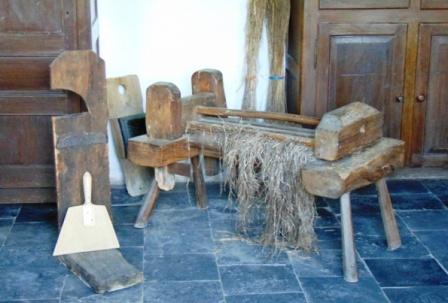When braking the flaxer will break the wooden pipe in pieces. First, they used a hand fallow, a kind of clamp. During broke the wooden parts of the plant were broken several times between open beams (jaws) of the set. (It looked like a paper cutter with multiple blunt arms.)
 They also put flax on the floor and a millstone driven by a horse, crushed by its weight the woody stems.
They also put flax on the floor and a millstone driven by a horse, crushed by its weight the woody stems.
End of the 19th century, the rolling brake came with over each other moving wood or cast iron cylinders between which the flax stalks were pushed.
As a result, the long fiber becomes free. To separate the straw fibers we'll scutch the retted flax (remove wood from the fiber). Now the pieces of wooden pipe (bark) are removed of the bundle of fibers without damaging the flax fibers. The flax workers used a simple scotching knife (stick to beat) and scotching board to beat or scrape the woody parts (wood scraps) from the fiber. Later, a kind of a winnower was used. This dusty work caused a disease like silicosis.
Shives (straw bits, pieces of wood core or pipe) are (as an addition) used in furniture panels, building boards and insulation, fuel and paper.
The resulting short flax fiber is ground into raw material for papermaking (including banknotes and cigarette paper).
